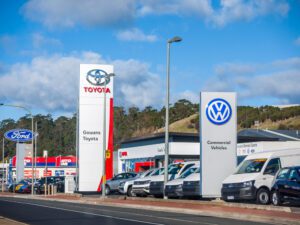In 2012, a San Diego Tribune article revealed that auto dealers in the region of Escondido spent $10 million to $12 million on dealership renovations and expansions. While city officials were happy for the seeming boost in auto sales due to these renovations, industry analyst, David Whitson remarked on the harmful impact these mandates could have on smaller automobile dealers. Seven years later, not much has changed.
 A recent Automotive News article highlighted dealers who are struggling through business disruptions and growing expenses due to showroom renovation mandates. According to the article, automakers like Porsche, Lincoln, and Mercedes seem to be listening and easing up on their requirements. However, many are still ignoring dealer sentiments and pushing for costly mandates. It is long overdue for manufacturers to take a closer look at their requests and how it is impacting today’s auto dealer. In fact, is it time for an overall re-evaluation of these mandates? Dealer sentiment and government involvement would indicate that changes are in order. So, read on for our top reasons for why automakers need to consider altering their approach to dealership renovation requests.
A recent Automotive News article highlighted dealers who are struggling through business disruptions and growing expenses due to showroom renovation mandates. According to the article, automakers like Porsche, Lincoln, and Mercedes seem to be listening and easing up on their requirements. However, many are still ignoring dealer sentiments and pushing for costly mandates. It is long overdue for manufacturers to take a closer look at their requests and how it is impacting today’s auto dealer. In fact, is it time for an overall re-evaluation of these mandates? Dealer sentiment and government involvement would indicate that changes are in order. So, read on for our top reasons for why automakers need to consider altering their approach to dealership renovation requests.
They Create a Huge Barrier to Entry for Aspiring Dealership Owners
Large dealers with years in the game are still going to take a hit from multi-million-dollar renovation requests. However, smaller dealership owners are going to be the group that is the most adversely impacted. While a lot of capital and business expertise is involved, owning a dealership has been relatively attainable for the everyday entrepreneur. Outrageous renovation mandates not only make it harder for current dealers, but it excludes a large subset of the population from getting their footing as a dealership owner.
Does not Acknowledge the Trends of a Particular Area
Across-the-board mandated renovations don’t make sense for specific areas. According to the 2012 NADA Facility Study, “frequently changing OEM volume forecasts and outdated capacity formulas can lead to overbuilding and waste.” Sales projections in regions can consistently fluctuate. This situation makes it almost impossible for automakers to request renovations that support a store’s current sales pattern. Every dealership is different, and for a mandated upgrade to make sense, it would have to be customized to a specific dealership. By and large, this is not happening in most dealerships. Unfortunately, the results are wasted construction and spending.
States Keep Enacting Limits
Currently, 22 states have established limits on automaker dealership renovation mandates. Most only allow for dealerships to ask for renovations once every seven or ten years, while New Hampshire has established a 15-year limit. According to Automotive News, in 2017, Mercedes announced that they would adhere to a 10-year limit on store renovations after dealers completed a second-generation round of upgrades. This statement was followed by this sentence, “The rise of state laws setting limits was seen as a factor influencing the move.” The involvement of more states in establishing limits on these renovations is a clear indication that requests have become more than many dealers can handle. This development should be a huge concern for automakers, and should alone require each one to take a look at their renovation practices.
Consumers have Less of a Reason to Come into The Store
Today, the average consumer is conducting most of the car buying process online. This scenario means that the dealership is likely the last stop on their buyer journey. As a result, most consumers are coming into showrooms with an idea of what they already want. For current customers, dealer websites seem like more of a worthwhile investment than the facility itself. Failing to acknowledge this makes automakers seem out-of-touch with the evolution of the consumer’s interaction with dealerships. The 2012 NADA Facility Study touched on this concept by revealing that there is an apparent absence of quantifiable data that shows a real return on investment for dealers who participate in these costly renovations. With fewer individuals coming into dealerships to carry out the entire purchase process, it is likely that ROI may not be as high as hoped for.
Final Thoughts
Required mandates are a contentious issue for many dealers. They cause dealers to put up funds for expensive construction projects that may or may not yield an acceptable return. This reason is why it is crucial for manufacturers to re-evaluate these requests and see how they can better partner with auto dealers to agree on renovation requirements that work for everyone. If they do not do this, dealer push back will increase and more states may continue to have to step in over time. Both developments could have adverse long-term effects on automaker perception as well as dealership partnerships.








